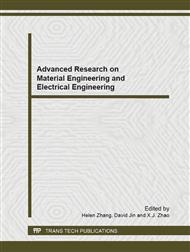[1]
Wang Bin, Jing Shi. Research of on-line analysis algorithms of low-frequency oscillation in power system base on WAMS[J]. ELECTRONIC TEST, vol. 10, No. 1, p.18–21, 2011.
Google Scholar
[2]
DANG Jie, LI Yong,XU Youping. Power Grid Low Frequency Oscillation Simulation Analysis Based on WAMS and Singular Entropy Matrix Pencil Method[J]. Automation of Electric power systems, vol. 34, No. 15, p.14–18, 2010.
Google Scholar
[3]
Ning Lin, Tan Jiancheng, Liang Zhijian. Parameter Optimization of PSS and TCSC Damping Controller Using Modified Particle Swarm Optimization Algorithm[J]. Modern Electric Pow er, vol. 25, No. 2, p.18–23, 2008.
Google Scholar
[4]
YANG Peihong, LIU Wenying, ZHANG Jihong. Restraining low frequency oscillation of inerconnected power grid using PSS and TCSC[J].Power System Protection and Control, vol. 39, No.12, p.11–16, 2011.
Google Scholar
[5]
LI Guojie, MA Feng. A Coordinated Tuning Algorithm for Power System Stabilizer and Supplementary Damping Controller of VSC-HVDC Transmission System[J]. Power System Technology,vol. 33, No. 11, p.39–43, 2009.
Google Scholar
[6]
Dejamkhooy A M, Banejad M, Talebi N. Fuzzy logic based UPFC controller for damping low frequency oscillations of power systems[C]. Power and Energy Conference, IEEE 2nd International. 2008:85-88.
DOI: 10.1109/pecon.2008.4762450
Google Scholar
[7]
DONG Xiao-rui,QIAO Kun.Research for Orient Mode and Key Technology of China's Smart Grid[J]. Jouranl of Electric Power, vol. 25, No. 4, p.287–291, 2010.
Google Scholar
[8]
GAO Hong, CHEN Ji jun.Application of Flexible AC Transmission Technique to Smart Grid[J]. Guangdong Electric Power, vol. 23, No. 9, p.21–26, 2010.
Google Scholar
[9]
ZHANG Mingrui, LIU Jinhui, JIN Xin . Research on the FREEDM micro-grid and its relay protection[J]. Power System Protection and Control, vol. 39, No. 7, p.95–104, 2011.
Google Scholar
[10]
CHEN Gesong, ZHOU Xiaoxin, SONG Ruihua.Design of Self-adaptive Damping Controller to Low Frequency Power Oscillation in Interconnected Power Systems Based on Variable Frequency Transformer[J]. Proceedings of the CSEE, vol. 31, No. 16, p.1–7, 2011.
Google Scholar
[11]
Hagstrom E, Norheim I, Uhlen K. Large-scale wind power integration in Norway and impact on damping in the Nordic grid[J]. Wind Energy, 2005, 8(3):375-384.
DOI: 10.1002/we.168
Google Scholar
[12]
Anaya-Lara O, Hughes F, Jenkins N, et al. Influence of windfarms on power system dynamic and transient stability[J]. Wind Engineering, 2006, 30(2):107-127.
DOI: 10.1260/030952406778055018
Google Scholar
[13]
Tsourakis G, Nomikos B M, Vournas C D. Effect of wind parks with doubly fed asynchronous generators on small-signal stability[J]. Electric Power Systems Research, 2009, 79(1):190-200.
DOI: 10.1016/j.epsr.2008.05.018
Google Scholar
[14]
Slootweg J, Kling W L. The impact of large scale wind power generation on power system oscillations[J]. Electric Power Systems Research, 2003, 67(1):9-20.
DOI: 10.1016/s0378-7796(03)00089-0
Google Scholar
[15]
Fan L, Miao Z, Osborn D. Impact of doubly fed wind turbine generation on inter-area oscillation damping[C]//IEEE Power and Energy Society General Meeting. Pittsburgh, PA:IEEE PES, 2008:1-8.
DOI: 10.1109/pes.2008.4596008
Google Scholar
[16]
Yang Lihui, Ma Xikui.Impact of Doubly Fed Induction Generator Wind Turbine on Power System Low-frequency Oscillation Characteristic[J], vol. 31, No. 10, p.19–25, 2011.
Google Scholar
[17]
Ni Yixin, Theory and analysis of dynamic power system, Beijing:Tsinghua University Publishing Company, 2002.
Google Scholar
[18]
P.Kunder, Power system stable and control, Beijing: China Power Publishing Company, 2002.
Google Scholar
[19]
Xiangning Lin, Pei Liu, Shijie Cheng, "Researches on faultidentification during fast power swings with wavelet transform based algorithm," Proceedings of the CSEE, vol. 20, No. 3, p.39–44, (2000)
DOI: 10.1109/pesw.2000.847652
Google Scholar
[20]
R. J. Murphy, "Power system disturbance monitoring," Western Protective Relay Conf, Spokane, WA, Oct. 17–20, 1994.
Google Scholar
[21]
R. Messina, O. Begovich M, and M. Nayebzadeh, Analytical investigation of the use of static VAR compensators to aid damping of inter-area oscillations, International Journal of Electrical Power & Energy Systems,vol. 21, pp.199-210, 1999.
DOI: 10.1016/s0142-0615(98)00044-1
Google Scholar
[22]
Zhijian Liu, shuming Zhou, Qi Song, Application of PMU-Based LEF Method to Analysis of Low-Frequency Oscillation in Power System,Journal of Kunming University of Science and Technology, Vol.37,No.3,pp.42-44,2012.
Google Scholar


